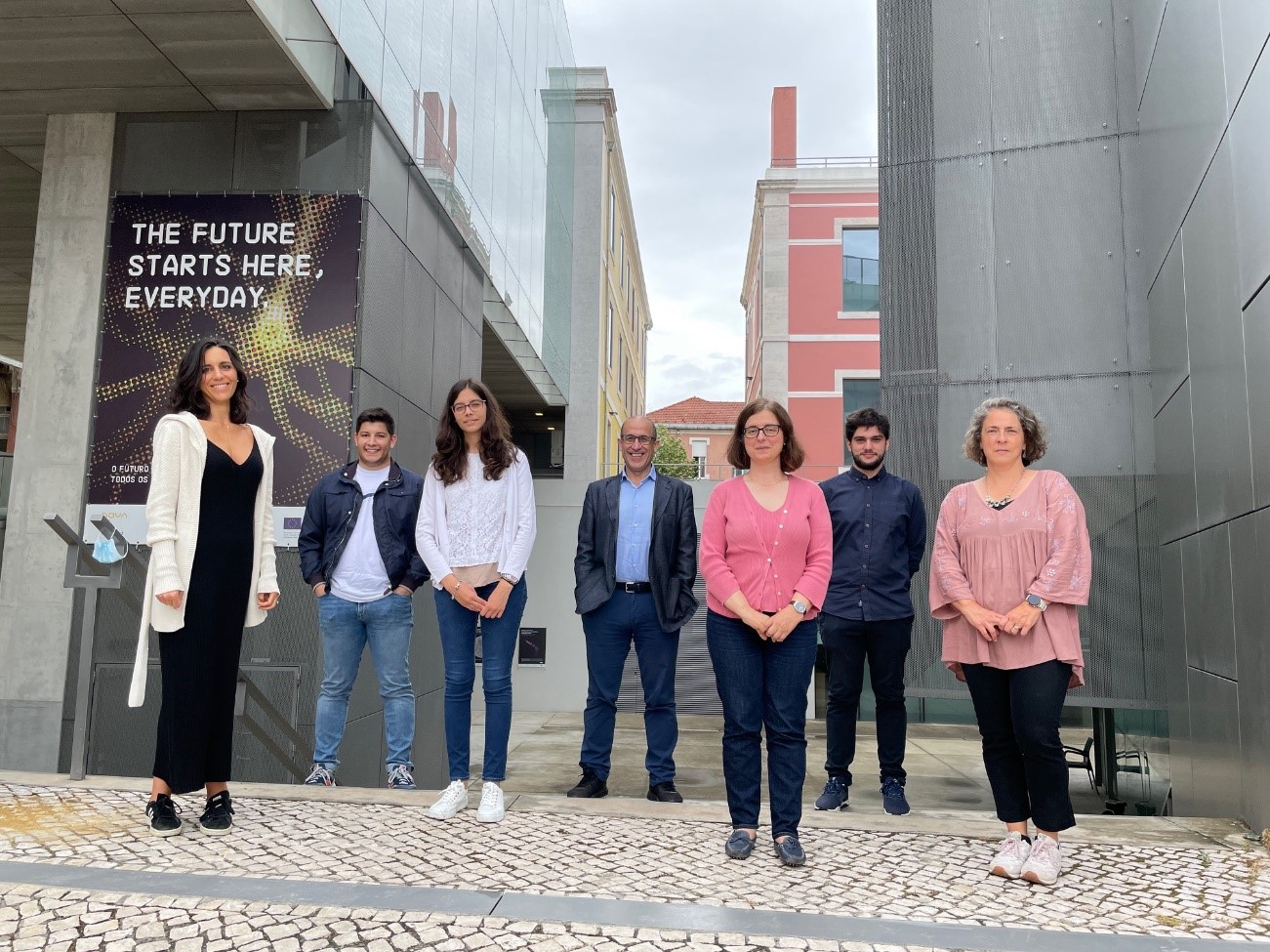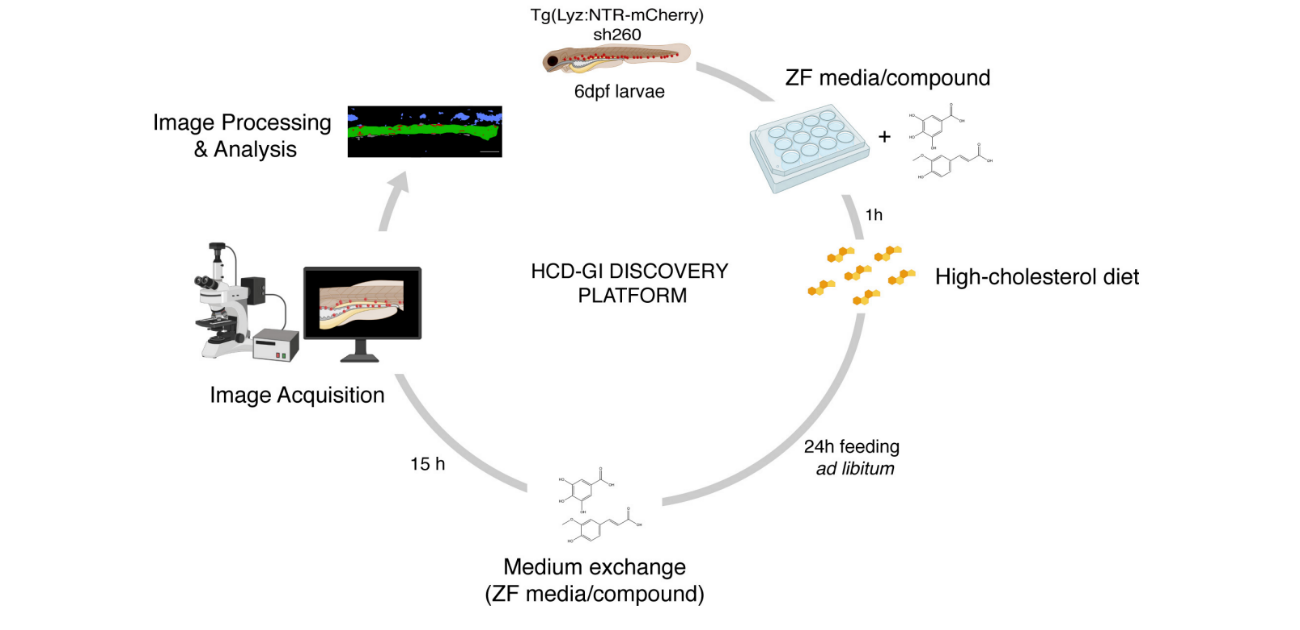Carolina Crespo led a join-effort between three CEDOC groups to publish in Frontier in Cell and Developmental Biology.

Authors from left to right: Carolina Crespo, Nuno Silva, Catarina Gonçalves, António Jacinto, Otília Vieira, Diogo Carregosa, Cláudia Nunes dos Santos
Nuno Silva, Diogo Carregosa and Catarina Gonçalves are all authors in a work that took place in Antonio Jacinto, Otília Oliveira and Cláudia Nunes Santos lab. The authors described a new innovative assay that can be used for drug discovery in Inflammatory Bowel Diseases (IBD), by using zebrafish as a model to impose a cholesterol diet that can help characterize the potential drug effect on intestinal inflamation diseases. The article is named "A Dietary Cholesterol-Based Intestinal Inflammation Assay for Improving Drug-Discovery on Inflammatory Bowel Diseases" and can be found here.
What discoveries led you to the research described in your publication?
Inflammatory bowel diseases (IBD) are chronic inflammatory disorders of the gastrointestinal tract that affect almost 7 million people globally and are largely incurable. The therapeutic targeting of IBD has been hampered by the complex nature of the disease, with cholesterol-enriched diets often playing a critical role. In fact, none of the present medications for IBD are curative or free from having significant side effects. Hence, there is an inevitable need to develop new therapeutic and nutraceutical approaches for the disease.
Zebrafish models of IBD have proven invaluable for drug discovery efforts on IBD. In fact, two high-content drug screens in chemically-induced zebrafish enterocolitis models have been performed to identify novel anti-inflammatory drugs for the disease. Yet, as those models are based on chemical damage, they are less physiological, may lead to toxicity or may provoke the tested compounds to lose their activity, and show extra-intestinal effects.
What were you trying to understand and what is the main discovery of this work?
This work was led by Carolina Crespo in António Jacinto’s lab and is a joint effort between three different groups at CEDOC, including António Jacinto’s lab (Tissue Repair And Inflammation), Cláudia Santos’ lab (Molecular Nutrition And Health) and Otília Vieira’s lab (Lysosomes In Chronic Human Pathologies And Infection).
In our collaborative work, we developed an in vivo assay in the zebrafish model that allows the identification of new anti-inflammatory molecules with potential relevance for IBD treatment. Besides, we show that the fruits- and vegetable-derived polyphenol metabolites, namely gallic acid and ferulic acid, are anti-inflammatory modifiers of intestinal inflammation.
Why is this important?
Our assay can facilitate and accelerate drug discovery on IBD, by identification of novel lead molecules with immune-modulatory action on intestinal inflammation. When we eat food rich in cholesterol there is a higher predisposition to develop a persistent intestinal infiltration of immune cells, the defendants of the organism. However, if those cells accumulate in the intestine in a persistent manner, they will become prejudicial. Hence, in our drug-discovery platform we use cholesterol-enriched food to trigger this strong recruitment of immune cells in the intestine, and we screen for anti-inflammatory molecules that may stop it. This will serve as a jumping-off point for more profound analyses of drug mechanisms of action involved in IBD immune responses.
Can you use an analogy to help us understand your work?
In humans, cholesterol enriched food may lead to intestinal inflammation by massive immune cell recruitment into the intestine. We use the zebrafish as a vertebrate model system to observe this response and to identify drugs that inhibit it, i.e., that are anti-inflammatory. The zebrafish are transparent at larval stages, and they can be engineered to have immune cells fluorescently labelled. This allows to easily monitor their recruitment into the intestine via microscopy, after larvae being fed with cholesterol, and to identify drugs that are anti-inflammatory and inhibit this process.
What questions remain to be asked?
In this work, we report the screening method and the anti-inflammatory effect of gallic acid and ferulic acid in intestinal inflammation. We are currently screening a library of diet-derived small molecules to then select the top anti-inflammatory candidates for future investigation and possible application into the clinic.

The high-cholesterol diet gut inflammation (HCD-GI) discovery platform. Schematic diagram illustrating the screening strategy for compounds modulating inflammation. Individual Tg(Lyz:NTR-mCherry)sh260 larvae, with fluorescent reporter expression in neutrophils, are distributed in 12-well plates with E3 zebrafish (ZF) medium supplemented with the compounds at 25 or 100 µM. After 1 h pre-treatment, larvae are fed with high-cholesterol diet (HCD) for 24 h. Larvae are then transferred to fresh medium supplemented with compounds were are kept for 15 h to allow inflammation and proper intestine emptying to occur. Larvae are finally fixed and imaged. Screening data are processed, and the neutrophilic inflammation index analyzed. Figure performed with images from Biorender.